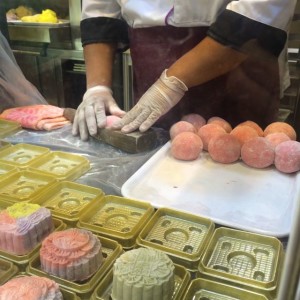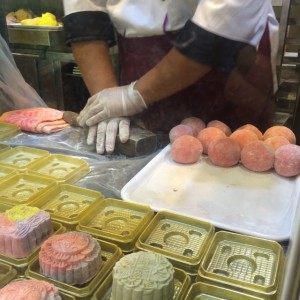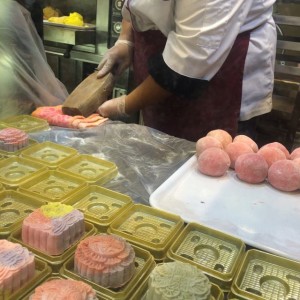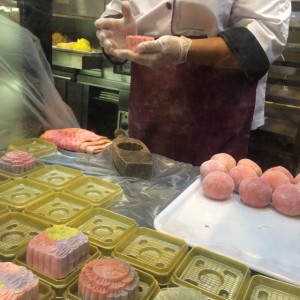
Photo Credit: redpolkadot via Flickr Creative Commons License.
In the last hour of our long plane ride on the leg from Hong Kong to Singapore, the man sitting next to us suddenly became chatty. He’d slept almost the whole way from San Francisco so he was well-rested and chipper. He’d lived in Singapore most of his life and gave us some recommendations on what to see and do during our visit. I don’t remember now how the conversation made it’s way to mooncakes, but I’m glad it did.
Sweet, dense, and highly caloric, mooncakes have been compared to American fruit cake, and the Mid Autumn Festival to which they’re tied has been compared to Thanksgiving. It’s celebrated across much of Asia, a remnant of China’s sweeping historical influence throughout the region.
Casually, he mentioned that if we wanted to try a bunch of different kinds of mooncakes, we should head to the basement of the Takashimaya mall on Orchard Road. Since we were staying at the Grand Hyatt nearby, mooncake tasting was definitely going to happen.
Mooncakes Everywhere
Before this trip, I had heard of mooncakes and even tasted a few traditional flavors during my excursions in San Francisco’s Chinatown, but I had no idea the scale of the mooncake mania we would encounter in Singapore.

Takashimaya Mid-Autumn Festival Celebrations
Mooncakes were everywhere, sold from every major hotel, bakery, and even Starbucks. Throughout our short stay in Singapore, we came across kiosk after kiosk specially set up to sell mooncakes for the month of September in advance of the Mid Autumn Festival. The only place we didn’t see mooncakes for sale was in Little India.
The degree of excitement and commerce surrounding the seasonal sales of mooncakes convinced me that I definitely shouldn’t miss tasting them at Takashimaya. Once I finally found myself in the basement of the mall (no small feat to find among the dizzying tunnels and connections from our hotel), I discovered a stadium sized room filled with vendor after vendor selling an array of mooncakes in all flavors, shapes, and sizes.

Mooncakes on Parade
Modern Mooncakes
Mooncakes are given as gifts to friends, family, and business associates as a symbol of the strength or importance of the relationship. According to an article in the Atlantic, the intricate packaging has become the most important part of the gift. So many mooncakes are given out, it’s unlikely anyone would eat all of the mooncakes they’re gifted.
“In the 1980s, mooncakes cost only one or two yuan (15 to 30 cents) apiece, but Mid-Autumn gift boxes today can cost hundreds of dollars. Part of the reason for this increase in price is the packaging, which has become extremely elaborate and is widely recognized as more important than the actual cakes.” From Mooncakes: China’s Evolving Tradition, The Atlantic.
In addition to changes in price and packaging, the mooncake itself has seen significant changes in recent years. Traditional mooncakes made of lotus seed paste or sweet bean paste with salted yolks in the middle have fallen out of favor with younger consumers, not unlike the fruitcake. The evolving kaleidoscope of colors and flavors, including the newer snow skin wrapper (seen below and made from mochi flour), are all an effort to recapture the longstanding appeal. Some now even include ice cream and chocolate, truly stretching the boundaries of what is actually a mooncake. And regifting is common.

Crazy Mooncake Flavors — On the left: Mini Peach Passionfruit Chocolate with Champagne Mousse. On the right: Mini Snowskin Mango Philadelphia Cream Cheese.
Despite the slide in their culinary appeal, mooncakes are still big business. The New York Times reported in 2014 that they bring in $2 billion in annual sales in greater China. That number includes Hong Kong, but doesn’t appear to capture the rest of Asia — Singapore, Vietnam, or Korea where the tradition is also celebrated. Based on my limited exposure to the mania surrounding them, that number doesn’t surprise me at all.

Baked Peach-shaped Mooncake with Single Yolk & Macademia Nuts in White Lotus Paste
The Tradition of Mooncakes
It’s still a bit of a mystery as to how all this hoopla with gifting mooncakes started. The cakes were originally baked during the harvest season and in conjunction with the Mid Autumn Festival, which is a time for gathering with family, thanksgiving, and also historically a time for moon worship. The Mid Autumn Festival is held on the 15th day of the 8th month of the Chinese calendar, when the moon is at is fullest.
Mythology and legend surround the origin of the mooncake and its importance. In the 14th century at the end of the Yuan Dynasty, Han Chinese are popularly believed to have passed messages inside them to facilitate an uprising against their Mongol rulers. Regardless of when the tradition started, it has withstood the test of centuries and continues on.

Traditional Flavors — On the left: White Lotus Seed Paste Mooncake. On the right: Red Bean Paste Mooncake

Mung Bean Paste Mooncake with Two Yolks. One of my favorites actually.
How to Make a Mooncake
A few of the mooncake sellers at Takashimaya had people on site making mooncakes for onlookers. Watching the process was lots of fun, and seeing how simple it was to make these fanciful delicacies made me want to share it with you. (How hadn’t I realized that there must be a mold used to make these designs?)
The only missing scene is the making of the filled mooncake balls before they’re put into the mold, which wasn’t on display. Obviously tons of prep was done in advance. Simple doesn’t mean necessarily quick.
Mooncakes are still a bit of a mystery to me, but thankfully one that helped open up a whole world of Chinese history and culture still alive through its descendants now living in modern day Singapore.




